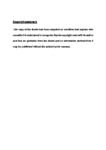Lab-scale bioremediation technology: the development of environmental biotechnology for the ex situ bioremediation of cadmium-contaminated freshwater
| dc.contributor.supervisor | Boden, Rich | |
| dc.contributor.author | Jebril, Nadia | |
| dc.contributor.other | School of Biological and Marine Sciences | en_US |
| dc.date.accessioned | 2020-10-22T09:03:39Z | |
| dc.date.issued | 2020 | |
| dc.identifier | 10456211 | en_US |
| dc.identifier.uri | http://hdl.handle.net/10026.1/16580 | |
| dc.description.abstract |
Cadmium (Cd) is one of the most common contaminates in freshwater. Among freshwater remediation techniques, bioremediation – the use of bacteria to extract Cd from water – is an eco-friendly technique. Cd-resistant bacteria evolve in the natural environment and can be used to develop a bioremediation process for Cd. However, gaining an adaptive strain is usually difficult. This research aimed to find an alternative bioremediation process for Cd from freshwater using Cd-resistant bacteria. To increase the Cd-resistance of the isolated Brevibacillus agri C15, UV-light mutagenesis was used to generate the mutant B. agri C15 CdR with a minimum inhibitory concentration (MIC) of 21 ± 0.4 mM Cd, which was approximately 0.25 – fold higher than that of the wild type B. agri C15 (MIC:16 ± 0.7 mM Cd). Laboratory bench-scale column reactors were operated for 28 days to investigate the effectiveness of the mutant B. agri C15 CdR entrapped in calcium alginate gel, as a bioremediation process for Cd from artificial groundwater (AGW) at different Cd concentrations (4.4, 8.8, 13.4 and 17.4 micromolar). A new process for the purpose of attaining high Cd removal rates from AGW was achieved using the mutant in this study. Scanning electron microscopy (SEM) observations enabled a detailed description of the beads, and the detection of Cd within the beads supported the Cd accumulation mechanism using a dithizone histochemical method. The interactions of Cd, cation/anion, and humic acid competing for ion exchange sites on Ca-alginate beads containing the mutant cells in addition to the effect of pH were investigated. The efficient removal of Cd was achieved from AGW at pH 4.00. The constituents were found to hinder Cd uptake due to the formation of Cd complexes. The preferential removal of Cd using the mutant from AGW (pH 4.00 and 7.50), as well as from natural river water (NRW, Walkham River), reflects its ability to remove Cd from freshwater in general. The hazard classification and risk assessment of the products of this study’s new bioremediation process was not hazardous substances and did not represent a risk to humans. From a biotechnology standpoint, this thesis presents new prospects for this maintainable water bioremediation technique and the knowledge assembled in this study may provide a basis for the development of other bacteria for metal remediation and for further research in investigating and applying this technique. | en_US |
| dc.description.sponsorship | Ministry of Higher Education and Scientific Research, Iraq (2014). | en_US |
| dc.language.iso | en | |
| dc.publisher | University of Plymouth | |
| dc.rights | Attribution-NonCommercial 3.0 United States | * |
| dc.rights.uri | http://creativecommons.org/licenses/by-nc/3.0/us/ | * |
| dc.subject | Bioremediation | en_US |
| dc.subject | cadmium | en_US |
| dc.subject | groundwater | en_US |
| dc.subject | minimum inhibitory concentration | en_US |
| dc.subject | reactor | en_US |
| dc.subject | risk assessment | en_US |
| dc.subject.classification | PhD | en_US |
| dc.title | Lab-scale bioremediation technology: the development of environmental biotechnology for the ex situ bioremediation of cadmium-contaminated freshwater | en_US |
| dc.type | Thesis | |
| plymouth.version | publishable | en_US |
| dc.identifier.doi | http://dx.doi.org/10.24382/1147 | |
| dc.rights.embargodate | 2021-10-22T09:03:39Z | |
| dc.rights.embargoperiod | 12 months | en_US |
| dc.type.qualification | Doctorate | en_US |
| rioxxterms.version | NA |
Files in this item
This item appears in the following Collection(s)
-
01 Research Theses Main Collection
Research Theses Main



